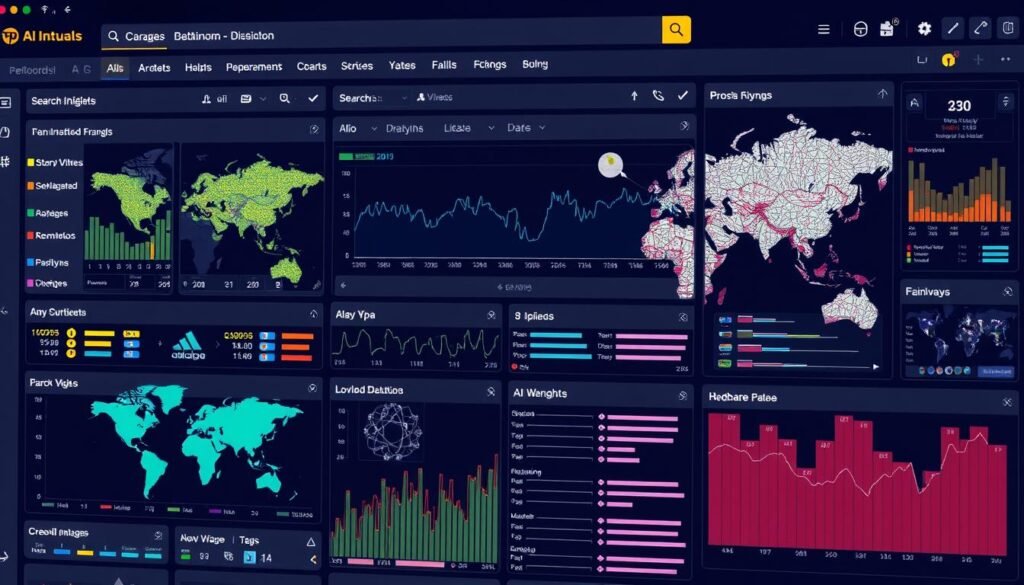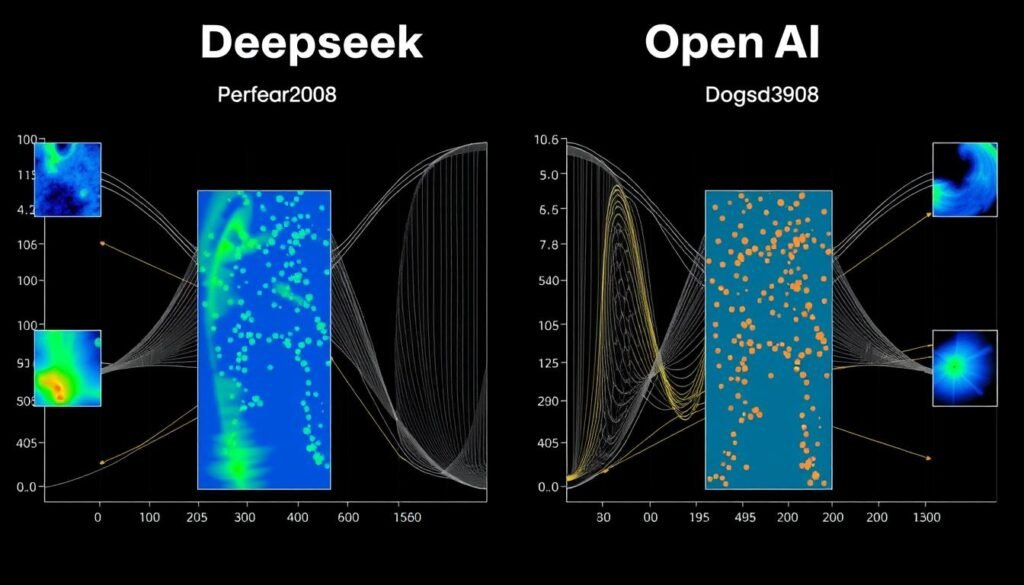DeepSeek R1 scored 0% in detecting AI-generated content, beating O3 Mini and O3 Mini High. This has sparked a lot of interest in comparing DeepSeek and OpenAI. As AI becomes more popular, it’s key to look at what each offers.
Companies like DeepSeek and OpenAI are at the forefront of AI innovation. The debate between DeepSeek and OpenAI has been ongoing. We’ll dive into their features, performance, and uses in this article.
For those looking to use AI, comparing DeepSeek and OpenAI is important. DeepSeek R1 excels in math, while OpenAI’s O3 Mini is faster in coding. The choice depends on your specific needs. We’ll explore the differences and their uses in various fields.
Key Takeaways
- DeepSeek R1 achieved a detectability score of 0% in a humanization test, outperforming O3 Mini and O3 Mini High.
- DeepSeek R1 offers superior math skills, while OpenAI’s O3 Mini has a speed edge in coding tasks.
- DeepSeek R1 is fully open-source, free for personal and commercial use, and operates under an MIT License.
- OpenAI’s offerings are described as subscription-based, lacking the open-source flexibility of DeepSeek R1.
- DeepSeek R1 allows for fine-tuning via API, while OpenAI has limited fine-tuning capabilities.
- DeepSeek scored 5.5 out of 6 on a competitive performance test, outperforming OpenAI’s o1 and ChatGPT-4o.
Introduction to DeepSeek and OpenAI
DeepSeek and OpenAI are big names in artificial intelligence. DeepSeek uses deep learning for data analysis and finding content. OpenAI is known for its GPT-4 model, which understands and writes like a human.
When looking at deepseek pricing and openai review, think about what your project needs. DeepSeek is great for digging deep into data. OpenAI is leading the way in artificial intelligence.
Overview of DeepSeek’s Capabilities
DeepSeek uses advanced algorithms for data analysis and finding content. It has features like natural language processing and machine learning. These help users find important insights in big datasets.
Overview of OpenAI’s Technologies
OpenAI’s tech supports many uses, from writing to making technical documents. It’s easy to integrate into projects with its well-documented API.
Key Differences Between the Two Platforms
DeepSeek and OpenAI differ in what they’re used for and how they work together with other systems. DeepSeek is better for certain tasks, like solving math problems, thanks to its R1 model. But OpenAI is more flexible for bigger projects.
When you look at deepseek pricing and openai review, remember the trade-offs. DeepSeek’s R1 model is much cheaper than OpenAI’s o1 model. Your choice should depend on what your project needs and how much support you want.
| Platform | DeepSeek | OpenAI |
|---|---|---|
| Application Scope | Content Discovery | Artificial General Intelligence |
| Integration Options | Limited | Easy API Integration |
| Pricing | Cost-Efficient | Premium |
Use Cases for DeepSeek
DeepSeek shines in areas where being open and flexible is key. It stands out because it lets developers tweak its models to fit their needs. This is a big plus compared to OpenAI, which focuses more on closed systems.
DeepSeek is great for industries like healthcare and finance. These fields need to understand how AI works. DeepSeek’s openness and clarity make it a top pick.
When comparing DeepSeek to other models, its strengths become clear. It’s perfect for certain tasks because of its adaptability and openness.
DeepSeek has some cool features. It works well on regular GPUs, saving money on hardware. It also uses open-source tools, which cuts down on costs.
- 20-40 times cheaper than equivalent models from OpenAI
- Utilizes a sparse activation strategy, reducing computational costs
- Can operate on consumer-grade GPUs, reducing hardware costs
- Relies on open-source tools and community contributions, reducing operational overhead

DeepSeek is a great choice for those who want a cost-effective, flexible AI solution. It’s perfect for industries and developers who value openness and efficiency.
| Model | Parameters | Cost |
|---|---|---|
| DeepSeek-R1 | 671 billion | $6 million |
| ChatGPT | – | $500 million |
| Claude | – | $200 million |
Use Cases for OpenAI
OpenAI is becoming more popular because it can create high-quality content. This is useful for marketing, customer service, and data analysis. It’s a top choice for businesses looking for alternatives, thanks to its impressive performance.
It works well with other technologies like chatbots and virtual assistants. This makes customer experiences smooth and seamless.
OpenAI is great for creating content, helping with customer service, and analyzing data. For example, it can write blog posts and social media content. This helps businesses improve their online presence.
It can also analyze big datasets. This gives businesses valuable insights to make better decisions. When looking at OpenAI reviews, it’s important to see how it performs in different tasks.

OpenAI has a strong community and ecosystem support. Many developers and researchers help improve it. This has led to a wide range of tools and applications.
As businesses search for OpenAI alternatives, they should look at its performance. They should also see how it can work with other technologies. This ensures seamless customer experiences.
Performance Metrics and Comparisons
When we look at DeepSeek and OpenAI, we see important metrics like speed, efficiency, accuracy, and reliability. The cost, or deepseek pricing, is also key. DeepSeek-R1 is faster, processing data 2.4 times as fast as OpenAI’s o1 model. This makes it better for big tasks.
OpenAI’s o3-mini does well in coding and search tasks. But DeepSeek-R1 beats it in math and making AI content seem human. This shows the deepseek benefits of using this platform.

- DeepSeek-R1’s response time for coding tasks: 1 minute 45 seconds
- OpenAI o3-mini’s response time for coding tasks: 27 seconds
- DeepSeek-R1’s cost per million input tokens (cache hit): $0.14
- OpenAI o3-mini’s cost per million input tokens: $1.10
The choice between DeepSeek and OpenAI depends on what you need. Think about deepseek pricing, openai performance, and deepseek benefits. This helps you decide which platform is right for you.
Conclusion: Which One to Choose?
DeepSeek and OpenAI both bring unique benefits to the AI world. is great for specific tasks with its custom models and quick answers. On the other hand, ‘s is versatile and reliable, loved by both businesses and people.
stands out with its vast training data, top compliance, and easy integration with big software. It’s also known for its ethical AI and wide knowledge. , though, is cheaper and better for fast, specific answers in areas like customer service and healthcare.
Choosing between and depends on your needs. The AI world is always changing, and and others will keep pushing what’s possible. Staying flexible is key to using these tools to their fullest.
FAQ
What are the key differences between DeepSeek and OpenAI?
What are the typical use cases for DeepSeek?
What are the typical use cases for OpenAI?
How do DeepSeek and OpenAI compare in terms of performance metrics?
What factors should I consider when choosing between DeepSeek and OpenAI?
Source Links
- DeepSeek R1 vs OpenAI O3 Mini: The Ultimate AI Showdown – https://medium.com/@pratikabnave97/deepseek-r1-vs-openai-o3-mini-the-ultimate-ai-showdown-1217d5774074
- DeepSeek R-1 Review: The Open Source Alternative to OpenAI – https://www.greptile.com/blog/deepseek-review
- Putting DeepSeek to the test: how its performance compares against other AI tools – https://theconversation.com/putting-deepseek-to-the-test-how-its-performance-compares-against-other-ai-tools-248368
- How OpenAI is Better Than Deepseek: An In-Depth Comparison – https://medium.com/@HardikKawale/how-openai-is-better-than-deepseek-an-in-depth-comparison-44fe95af927e
- What DeepSeek Really Changes About AI Competition – https://www.rand.org/pubs/commentary/2025/02/what-deepseek-really-changes-about-ai-competition.html
- 🐳7 Reasons DeepSeek Beat OpenAI with Just 5% of Their Budget – https://ai.plainenglish.io/tech-wise-how-deepseek-beat-openai-with-just-5-of-their-budget-6aa30bbe8677
- What is DeepSeek & How Does It Work? Benefits & Use Cases – https://www.revechat.com/blog/what-is-deepseek/
- What Is DeepSeek? A Complete Breakdown – https://www.linkedin.com/pulse/what-deepseek-complete-breakdown-saasguruhq-bsfxf
- How DeepSeek Defeated OpenAI In Its Own Game? – https://www.kommunicate.io/blog/how-deepseek-defeated-openai-in-its-own-game/
- How DeepSeek is Reshaping the AI Landscape | FXMedia: Solutions for Metaverse – https://www.fxmweb.com/insights/how-deepseek-is-reshaping-the-ai-landscape.html
- Is OpenAI’s o3-mini Better Than DeepSeek-R1? – https://www.analyticsvidhya.com/blog/2025/02/openai-o3-mini-vs-deepseek-r1/
- DeepSeek Open-Sources DeepSeek-R1 LLM with Performance Comparable to OpenAI’s o1 Model – https://www.infoq.com/news/2025/02/deepseek-r1-release/
- DeepSeek-R1: The Open-Source Powerhouse Challenging OpenAI’s Reign – https://opentools.ai/news/deepseek-r1-the-open-source-powerhouse-challenging-openais-reign
- ChatGPT vs DeepSeek – https://logicvein.com/chatgpt-vs-deepseek
- DeepSeek vs ChatGPT: Which AI Chatbot is Better? – https://www.index.dev/blog/deepseek-chatgpt-comparison
- DeepSeek juices the geopolitics of AI – Asia Times – https://asiatimes.com/2025/02/deepseek-juices-the-geopolitics-of-ai/
